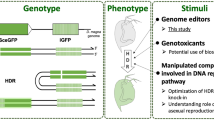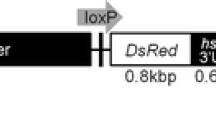Abstract
Currently, little information is available regarding the molecular organization of integrated transgenes in genetically-engineered fish. We performed a detailed structural analysis of an inserted transgene in one strain (M77) of transgenic coho salmon (Oncorhynchus kisutch) containing a salmon growth hormone gene construct (OnMTGH1). Microinjected DNA was found to have inserted into a single site in the coho salmon genome, and was organized with four complete internal copies and two partial terminal copies of the OnMTGH1 construct. All construct copies were organized in a direct-tandem (head-to-tail) repeat fashion in strain M77 and five additional strains (one also possessed a second recombinant junction fragment). For strain M77, the junctions between the transgene insert and the insertion point within the wild-type genome were cloned from strain-specific cosmid libraries and sequenced, revealing that the transgene insertion was accompanied by a deletion of 587 bp of wild-type DNA as well as a small insertion (19 bp) of unknown DNA upstream and a 14 bp direct- tandem duplication of sequence downstream. Upstream and downstream wild-type DNA sequence contained several repetitive sequence elements based on Southern blot analysis and homology to repetitive sequences in GenBank. In the downstream flank, a pseudogene sequence was also identified which has high homology to the CA membrane protein gene from Schistosoma japonicum, a parasite closely related to Sanguinicola sp. parasites which infect salmonids. Whether the presence of an inserted transgene and the presence of potentially horizontally-transmitted DNA are indicative of a genomic region with a predisposition for insertion of foreign DNA requires further study. The information derived from this transgene structure provides information useful for comparison to other transgenic organisms and for determination of the mechanism of transgene integration in lower vertebrates.
Similar content being viewed by others
References
Aigner B, Fleischmann M, Muller M, Brem G (1999) Stable long term germ-line transmission of transgene integration sites in mice. Transgenic Res 8:1–8
Allen M, Jeffreys A, Surani M, Barton S, Norris M, Collick A (1994) Tandemly repeated transgenes of the human minisatellite MS32 (D1S8), with novel mouse gamma satellite integration. Nucleic Acids Res 22:2976–2981
Been M, Burgess R, Champoux J (1984) Nucleotide sequence preference at rat liver and wheat germ type 1 DNA topoisomerase breakage sites in duplex SV40 DNA. Nucleic Acids Res 12:3097–3114
Brown A, Copeland N, Gilbert D, Jenkins N, Rossant J, Kothary R (1994) The genomic structure of an insertional mutation in the Dystonia Musculorum locus. Genomics 20:371–376
Bullock P, Champoux J, Botchan M (1985) Association of crossover points with topoisomerase I cleavage sites: a model for nonhomologous recombination. Science 230:954–958
Chan W-K, Devlin RH (1993) Polymerase chain reaction amplification and functional characterization of sockeye salmon histone H3, metallothionein-B, and protamine promoters. Mol Mar Biol Biotech 2:308–318
Covarrubias L, Nishida Y, Mintz B (1986) Early postimplantation embryo lethality due to DNA rearrangements in a transgenic mouse strain. Proc Natl Acad Sci USA 83:6020–6024
Covarrubias L, Nishida Y, Terao M, D’Eustachio P, Mintz B (1987) Cellular DNA rearrangements and early developmental arrest caused by DNA insertion in transgenic mouse embryos. Mol Cell Biol 7:2243–2247
de Noya B, Pointier J, Colmenares C, Theron A, Balzan C, Cesari I, Gonzalez S, Noya O (1997) Natural Schistosoma mansoni infection in wild rats from Guadeloupe: parasitological and immunological aspects. Acta Trop 68:11–21
Devlin RH (1993) Sequence of sockeye salmon type 1 and 2 growth hormone genes and the relationship of rainbow trout with Atlantic and Pacific salmon. Can J Fish Aquat Sci 50:1738–1748
Devlin RH, Biagi CA, Smailus DE (2001) Genetic mapping of Y-chromosomal DNA markers in Pacific salmon. Genetica 111:43–58
Devlin RH, Biagi CA, Yesaki TY (2004) Growth, viability and genetic characteristics of GH transgenic coho salmon strains. Aquaculture 236:607–632
Devlin RH, Yesaki TY, Biagi CA, Donaldson EM, Swanson P, Chan WK (1994) Extraordinary salmon growth. Nature 371:209–210
Devlin RH, Yesaki TY, Donaldson EM, Du SJ, Hew C-L (1995a) Production of germline transgenic Pacific salmonids with dramatically increased growth performance. Can J Fish Aquat Sci 52:1376–1384
Devlin RH, Yesaki TY, Donaldson EM, Hew C-L (1995b) Transmission and phenotypic effects of an antifreeze/GH gene construct in coho salmon (Oncorhynchus kisutch). Aquaculture 137:161–169
Du SJ, Devlin RH, Hew CL (1993) Genomic structure of growth hormone genes in chinook salmon (Oncorhynchus tshawytscha): presence of two functional genes, GH-I and GH-II, and a male-specific pseudogene, GH-psi. DNA Cell Biol 12:739–751
Edwards K, Halligan B, Davis J, Nivera N, Liu L (1982) Recognition sites of eukaryotic DNA topoisomerase I: DNA nucleotide sequencing analysis of topo I cleavage sites on SV40 DNA. Nucleic Acids Res 10:2565–2576
Evans W (1974) Growth, mortality, and hematology of cutthroat trout experimentally infected with the blood fluke Sanguinicola klamathensis. J Wildl Dis 10:341–346
Garrick D, Fiering S, Martin D, Whitelaw E (1998) Repeat induced gene silencing in mammals. Nat Genet 8:56–59
Gogarten J (2003) Gene transfer: gene swapping craze reaches eukaryotes. Curr Biol 13:53–54
Goodier J, Davidson W (1994) Tc1 Transposon-like sequences are widely distributed in salmonids. J Mol Biol 241:26–34
Halligan B, Davis J, Edwards K, Liu L (1982) Intra- and intermolecular strand transfer by HeLa DNA topoisomerase I. J Biol Chem 257:3995–4000
Hamada T, Sasaki H, Seki R, Sakaki Y (1993) Mechanism of chromosomal integration of transgenes in microinjected mouse eggs: sequence analysis of genome-transgene and transgene-transgene junctions at two loci. Gene 128:197–202
Kanamura H, Hoshino-Shimizu S, da Silva L (1992) Schistosoma mansoni cercaria and schistosomulum antigens in serodiagnosis of schistosomiasis. Bull Pan Am Health Organ 26:220–229
Kato S, Anderson R, Camerini-Otero R (1986) Foreign DNA introduced by calcium phosphate is integrated into repetitive DNA elements of the mouse L cell genome. Mol Cell Biol 6:1787–1795
King J, Fairley C, Morgan W (1994) Joining of nonhomologous ends by DNA polymerases. J Biol Chem 269:13061–13064
Kirk R, Lewis J (1998) Histopathology of Sanguinicola inermis infection in carp, Cyprinus carpio. J Helminthol 72:33–38
Knotts S, Rindt H, Robbins J (1995) Position independent expression and developmental regulation is directed by the beta myosin heavy chain gene’s 5′ upstream region in transgenic mice. Nucleic Acids Res 23:3301–3309
Kohli A, Twyman R, Abranches R, Wegel E, Stoger E, Christou P (2003) Transgene integration, organization and interaction in plants. Plant Mol Biol 52:247–258
Lieber M, Ma Y, Pannicke U, Schwarz K (2004) The mechanism of vertebrate nonhomologous DNA end joining and its role in V(D)J recombination. DNA Repair 3:817–826
Mahon K, Overbeek P, Westphal H (1988) Prenatal lethality in a transgenic mouse line is the result of a chromosomal translocation. Proc Natl Acad Sci USA 85:1165–1168
Makarevitch I, Svitashev S, Somers D (2003) Complete sequence analysis of transgene loci from plants transformed via microprojectile bombardment. Plant Mol Biol 52:421–432
Makarova I, Tarantul V, Gazarian K (1988) Structural features of the integration site of foreign DNA in the transgenic mouse genome. Mol Biol (Mosk) 22:1553–1561
Mark W, Signorelli K, Blum M, Kwee L, Lacy E (1992) Genomic structure of the locus associated with an insertional mutation in the line 4 transgenic mice. Genomics 13:159–166
Martinez R, Arenal A, Estrada MP, Herrera F, Huerta V, Vazquez J, Sanchez T, de la Fuente J (1999) Mendelian transmission, transgene dosage and growth phenotype in transgenic tilapia (Oreochromis hornorum) showing ectopic expression of homologous growth hormone. Aquaculture 173:271–283
McFarlane M, Wilson J (1996) A model for the mechanism of precise integration of a microinjected transgene. Transgenic Res 5:171–177
McLean E, Devlin RH (2000). Application of biotechnology to enhance growth of salmonids and other fish. In: Fingerman M, Nagabhushnam R, Thompson M-F (eds) Recent advances in marine biotechnology. Science Publishers Incorporated, Enfield, New Hampshire, USA, pp 17–55
Melamed P, Chong KL, Johansen MV (2004) Evidence for lateral gene transfer from salmonids to two Schistosome species. Nat Genet 36:786–787
Miao G, Smeyne R, D’Arcangelo G, Copeland N, Jenkins N, Morgan J, Curran T (1994) Isolation of an allele of reeler by insertional mutagenesis. Proc Natl Acad Sci USA 91:11050–11054
Muzzall P (2000) Occurence of Sanguinicola occidentails Van Cleave and Mueller, 1932 in Perca flavescens and Campeloma decisum from a Michigan creek. J Parasitol 86:1360–1362
Naora H, Kimura M, Otani H, Tokoyama M, Koizumi T, Katsuki M, Tanaka O (1994) Transgenic mouse model of hemifacial microsomia: cloning and characterization of insertional mutation region on chromosome 10. Genomics 23:515–519
Palmiter RD, Brinster RL, Hammer RE, Trumbauer ME, Rosenfeld MG, Birnberg NC, Evans RM (1982) Dramatic growth of mice that develop from eggs microinjected with metallothionein-growth hormone fusion genes. Nature 300:611–615
Pawlowski W, Somers D (1998) Transgenic DNA integrated into the oat genome is frequently interspersed by host DNA. Proc Natl Acad Sci USA 95:12106–12110
Perry IW, Vasicek T, Lee J, Rossi J, Zeng L, Zhang T, Tilghman S, Costantini F (1995) Phenotypic and molecular analysis of a transgenic insertional allele of the mouse fused locus. Genetics 141:321–332
Radice A, Bugaj B, Fitch D, Emmons S (1994) Widespread occurrence of the Tc1 transposon family: Tc1-like tranasposons from teleost fish. Mol Gen Genet 244:606–612
Rahman M, Hwang G-L, Razak S, Sohm F, Maclean N (2000) Copy number related transgene expression and mosaic somatic expression in hemizygous and homozygous transgenic tilapia (Oreochromis niloticus). Transgenic Res 9:417–427
Reed K (1999) Tc1-like transposable elements in the genome of lake trout (Salvelinus namaycush). Mar Biotechnol 1:60–67
Rohan R, King D, Frels W (1990) Direct sequencing of PCR-amplified junction fragments from tandemly repeated transgenes. Nucleic Acids Res 18:6089–6095
Romano A, Raemakers K, Bernardi J, Visser R, Mooibroek H (2003) Transgene organisation in potato afterparticle bombardment-mediated (co-)transformation using plasmids and gene cassettes. Transgenic Res 12:461–473
Roth D, Wilson J (1986) Nonhomologous recombination in mammalian cells: role for short sequence homologies in the joining reaction. Mol Cell Biol 6:4295–4304
Schell S (1974) The life history of Sanguinicola idahoensis sp. n. (Trematoda: Sanguiniolidae), a blood parasite of steelhead trout, Salmo gairdneri Richardson. J Parasitol 60:561–566
Shears MA, Fletcher GL, Hew CL, Gauthier S, Davies PL (1991) Transfer, expression, and stable inheritance of antifreeze protein genes in Atlantic salmon (Salmo salar ). Mol Mar Biol Biotechnol 1:58–63
Smiraglia D, Ratty A, Gross K (1997) Physical characterization of the chromosomal rearrangements that accompany the transgene insertion in the chakragati mouse mutant. Genomics 45:562–571
Smith S, Metcalfe J, Elgar G (2001) Characterisation of two topoisomerase 1 genes in the pufferfish (Fugu rubripes). Gene 265:195–204
Tewari R, Michard-Vanhée C, Perrot E, Chourrout D (1992) Mendelian transmission, structure and expression of transgenes following their injection into the cytoplasm of trout eggs. Transgenic Res 1:250–260
Thode S, Schäfer A, Pfeiffer P, Vielmetter W (1990) A novel pathway of DNA end-to-end joining. Cell 60:921–928
Wilkie T, Palmiter R (1987) Analysis of the integrant in MyK-103 transgenic mice in which males fail to transmit the integrant. Mol Cell Biol 7:1646–1655
Wu B, Sun Y-H, Wang Y-P, Wang Y-W, Zhu Z-Y (2004) Sequences of transgene insertion sites in transgenic F4 common carp. Transgenic Res 13:95–96
Wu B, Sun Y-H, Wang Y-W, Wang Y-P, Zhu Z-Y (2005) Characterization of transgene integration pattern in F4 hGH-transgenic common carp (Cyprinus carpio L.). Cell Res 15:447–454
Acknowledgment
The authors gratefully acknowledge research support from the Canadian Regulatory System for Biotechnology.
Author information
Authors and Affiliations
Corresponding author
Rights and permissions
About this article
Cite this article
Uh, M., Khattra, J. & Devlin, R.H. Transgene constructs in coho salmon (Oncorhynchus kisutch) are repeated in a head-to-tail fashion and can be integrated adjacent to horizontally-transmitted parasite DNA. Transgenic Res 15, 711–727 (2006). https://doi.org/10.1007/s11248-006-9016-4
Received:
Accepted:
Published:
Issue Date:
DOI: https://doi.org/10.1007/s11248-006-9016-4




